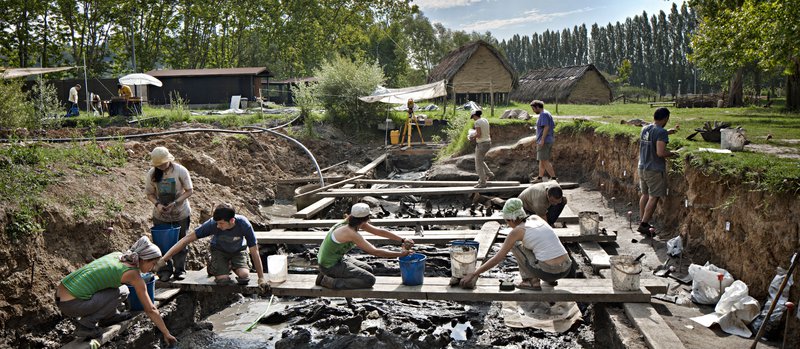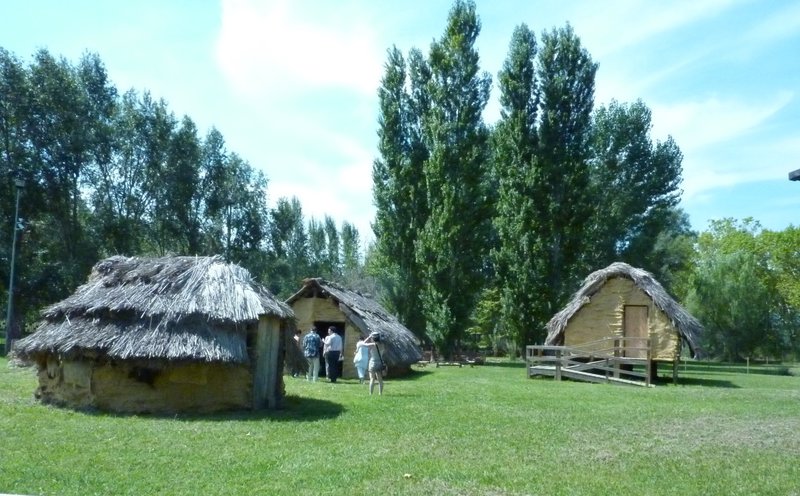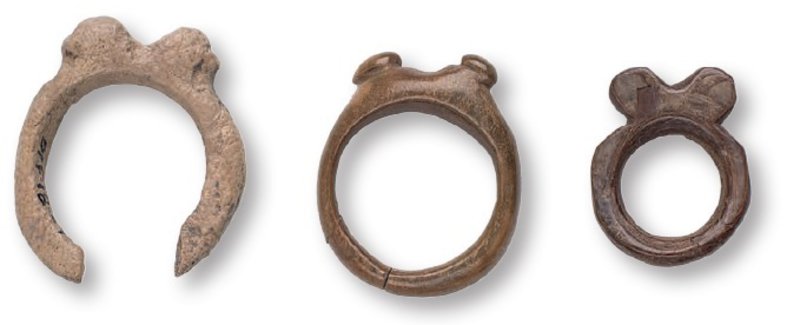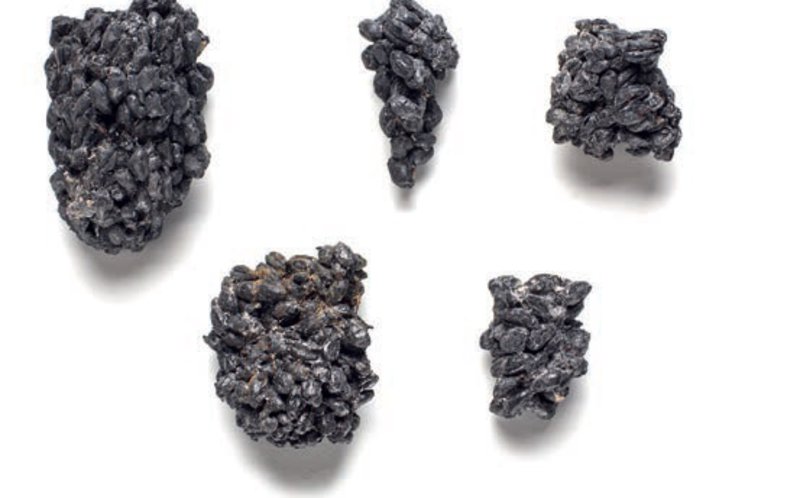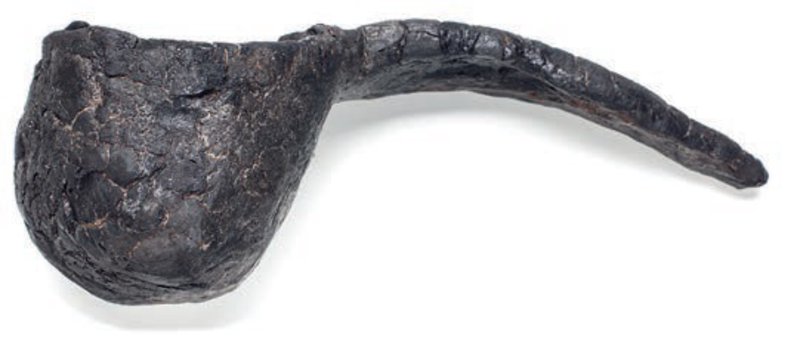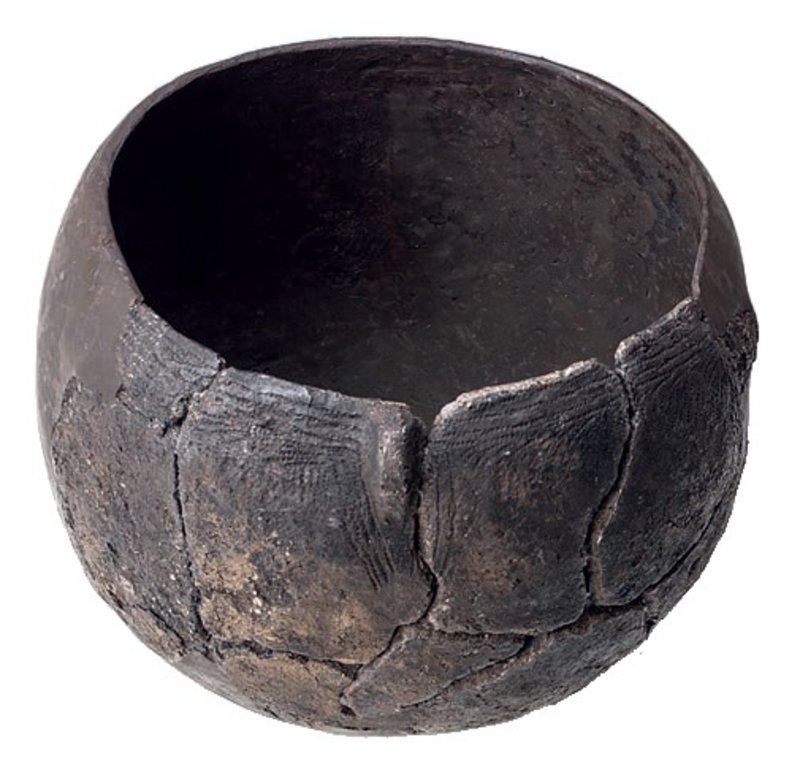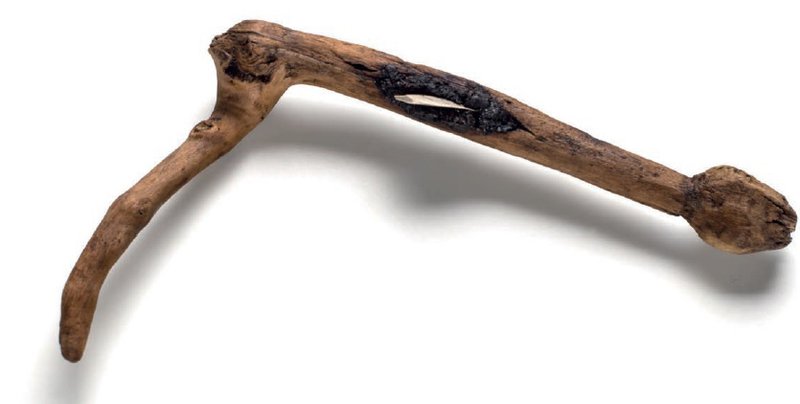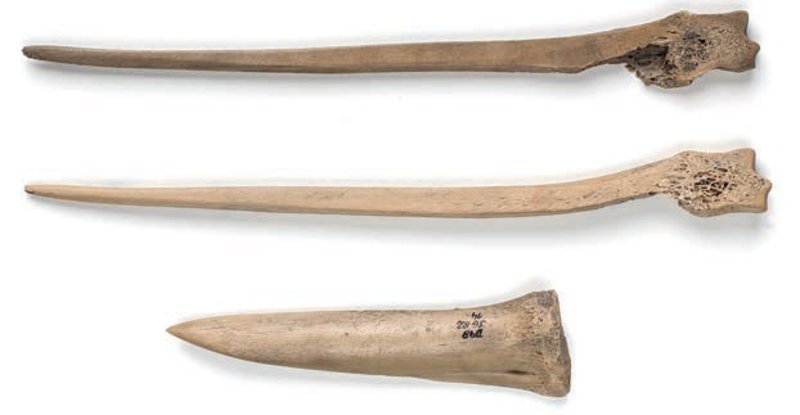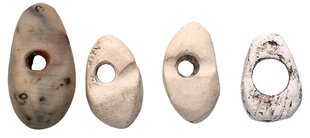A unique archeological site next to the lake
Work on the Olympic facilities in Banyoles 30 years ago brought to light an amazing archaeological site. La Draga has made it possible to find out much about life in a Neolithic village 7,400 years ago
Aside from urban remodelling and new rowing facilities, the 1992 Olympic Games also left another, unexpected legacy in Banyoles: the discovery of the Neolithic village of La Draga, which was uncovered during work on the park that was being built next to the lake. The first exploratory archaeological excavation carried out in order to date the remains and assess their importance took place in April 1990.
“Thirty years ago, it was difficult to judge the magnitude of the find but since then the results of each of the excavation campaigns that have been carried out uninterruptedly have continued to confirm that La Draga is the most important Neolithic settlement in Catalonia, the only archaeological lake site on the Iberian Peninsula, and one of the oldest and most important in the western Mediterranean,” says Miquel Cuenca, councillor for culture, heritage and festivities on Banyoles council.
Indeed, more than 100,000 wood, stone, bone and horn objects have been recovered from La Draga, providing information on what life was like in that environment 7,400 years ago, when a group of newcomers settled there. The site was inhabited for more than four centuries and experienced a real revolution: the beginnings of agriculture and livestock farming.
Thanks to the water
Viewed from the sky, Banyoles lake is shaped like a figure eight. La Draga is located on the east bank, at the waist of this eight, partially submerged and below the water table. This circumstance has been key, as the humidity – and the lack of contact with oxygen – has preserved many items of organic origin, from the wooden remains of the huts to tools like bows, sickles, wooden handles, axes, ropes, wooden containers, digging sticks, spoons and baskets.
All of these findings come from the excavations coordinated by the Banyoles County Archaeological Museum over the past 30 years. This museum, the UAB (Barcelona Autonomous University), the CSIC (Spanish National Research Council) and the Archaeology Museum of Catalonia are the four institutions in charge of interdisciplinary research related to the site. In addition, from the outset the work has had the support of the Catalan government’s Department of Culture, and more than 50 specialist scientists from various countries around the world have worked to help build interpretive models of La Draga.
Archaeologist Xavier Terradas – a CSIC researcher and one of the co-directors of the excavations since 2008 – explains how the research has evolved. “Sampling has changed, we now have the ability to do many tests that were unthinkable a few years ago (DNA, isotopes, fats, fibres, parasites...) and this means that specific sampling techniques are applied in each case.” What has not changed are the logistics. Excavations are almost always done in the summer, as that’s when the day is longer and the most can be made of the time available.
Digging in summer also allows for student participation. “In most excavations, no one is paid, so the work is very much based on the participation of volunteers and students doing internships,” says Terradas. Yet, whoever the participants might be, they have the opportunity to witness such exciting discoveries as the one that took place in 2012, when a perfectly preserved bow - which given its size was likely made for a teenager - was found. Made of yew wood and probably a status symbol, it is the oldest Neolithic bow in Europe. According to archaeological data, meat from wild animals likely played a very small role in the diet of those times, as wild animals only account for 2% of the total bone remains recovered.
Daily life
The village was the centre of all activities and consisted of wooden structures (huts, sheds and fences where people and livestock lived together), while around it were orchards, fields, places where food was stored and places where rubbish was thrown away (remains show they ate pig, ox, goat, and lamb, but also birds, fish and wild animals, such as deer and wild boar). Yet, no human remains have been found in La Draga. “From what we know of the early Neolithic times, the dead used to be buried in enclosed spaces, such as caves and shelters, so it would be rare to find them,” says Terradas.
Researchers believe the village was abandoned because it became a flood zone, both due to rising groundwater levels and the surrounding waterways. “This meant that the inhabited space had to be repaired more often than normal, which is why they chose to change their location, but without leaving the lake environment,” he says.
One of the biggest unknowns about the site is to discover the layout of the huts and how they were grouped. “We should dig more in the area where the wood remains are better preserved, but for logistical and budgetary reasons we can’t do so. It is the great paradox. La Draga is a unique site that allows us to answer questions like no other site can, but we aren’t able to get these data because we don’t have the means to,” says the researcher.
Contact with neighbours
One aspect that is known and that may seem surprising today is that despite being a more or less sedentary community, the inhabitants of La Draga were very mobile. Among the finds are shells collected on the coast and flint stones from the Narbonne area, 130 kilometres to the north. Therefore, we can surmise that they moved to get the resources they needed, while also maintaining contacts and links with neighbouring communities, with whom they exchanged information, products, technical knowledge, and even people, in what we might call marriages.
Many ornaments have been found at the site, such as rings, beads and pendants. “La Draga,” says Terradas, “was an important town. This meant that different spaces were dedicated to the production of a variety of goods. There were areas set aside for workshops, while others were used to deposit waste from these activities. Thanks to the fact that we’ve excavated a large area (almost 1,000 m²) and the exceptional conditions of conservation, we’ve recovered a lot of evidence of the production of these ornaments, something unthinkable in most sites of the same chronology.”
Yet, although much has been excavated, it is estimated that only 7% of all the remains have been found so far. It is not known exactly how many huts there may be or whether they were all contemporary or whether new ones were built as the old ones became unused. Researchers believe that the huts would have a maximum lifespan of about 60 years, meaning new ones would have to be built, sometimes taking advantage of existing structures. “In any case,” adds Terradas, “we estimate that no more than 30 or 40 people probably lived there at any one time, but it is difficult to prove right now. We know that the total area of the village was not less than 15,000 m². However, this does not mean a town of this size was always in operation, but rather the sum of several spaces inhabited throughout that the period that the place was occupied.“
La Draga has been a cultural asset of national interest (known as BCIN) since September 2018. Miquel Cuenca claims it as one of the privileged settings for understanding and explaining a fundamental moment in human development: the Neolithic revolution. “The intrinsic importance of the site motivated the construction of the pioneering La Draga Neolithic Park as an extension of the Banyoles County Archaeological Museum,” he says.
20,000 visitors
According to the councillor, La Draga has become the focal point for the other archaeological sites in the Pla de l’Estany area: the prehistoric Serinyà Caves and Incarcal, and from the ancient age, Vilauba and Ermedàs. “It’s no coincidence that last year it had more than 20,000 visitors,” he says. He also stresses that the site has been fully incorporated into the collective imagination of the local people in Banyoles, as witnessed by the fact that a reference to the village was used in a recent campaign against sexist violence aimed at young people.
Yet, Cuenca argues that interest in the site goes beyond mere curiosity. “Because of the rigor and quality of the excavations, due to its enormous potential for providing data and for its heritage appeal, the Neolithic Park of La Draga will continue to grow and become one of the cultural and tourist highlights of Banyoles in the coming decades,” he predicts.
feature
tonomous University), the CSIC (Spanish National Research Council) and the Archaeology Museum of Catalonia are the four institutions in charge of interdisciplinary research related to the site. In addition, from the outset the work has had the support of the Catalan government’s Department of Culture, and more than 50 specialist scientists from various countries around the world have worked to help build interpretive models of La Draga.
Archaeologist Xavier Terradas – a CSIC researcher and one of the co-directors of the excavations since 2008 – explains how the research has evolved. “Sampling has changed, we now have the ability to do many tests that were unthinkable a few years ago (DNA, isotopes, fats, fibres, parasites...) and this means that specific sampling techniques are applied in each case.” What has not changed are the logistics. Excavations are almost always done in the summer, as that’s when the day is longer and the most can be made of the time available.
Digging in summer also allows for student participation. “In most excavations, no one is paid, so the work is very much based on the participation of volunteers and students doing internships,” says Terradas. Yet, whoever the participants might be, they have the opportunity to witness such exciting discoveries as the one that took place in 2012, when a perfectly preserved bow - which given its size was likely made for a teenager - was found. Made of yew wood and probably a status symbol, it is the oldest Neolithic bow in Europe. According to archaeological data, meat from wild animals likely played a very small role in the diet of those times, as wild animals only account for 2% of the total bone remains recovered.
Daily life
The village was the centre of all activities and consisted of wooden structures (huts, sheds and fences where people and livestock lived together), while around it were orchards, fields, places where food was stored and places where rubbish was thrown away (remains show they ate pig, ox, goat, and lamb, but also birds, fish and wild animals, such as deer and wild boar). Yet, no human remains have been found in La Draga. “From what we know of the early Neolithic times, the dead used to be buried in enclosed spaces, such as caves and shelters, so it would be rare to find them,” says Terradas.
Researchers believe the village was abandoned because it became a flood zone, both due to rising groundwater levels and the surrounding waterways. “This meant that the inhabited space had to be repaired more often than normal, which is why they chose to change their location, but without leaving the lake environment,” he says.
One of the biggest unknowns about the site is to discover the layout of the huts and how they were grouped. “We should dig more in the area where the wood remains are better preserved, but for logistical and budgetary reasons we can’t do so. It is the great paradox. La Draga is a unique site that allows us to answer questions like no other site can, but we aren’t able to get these data because we don’t have the means to,” says the researcher.
Contact with neighbours
One aspect that is known and that may seem surprising today is that despite being a more or less sedentary community, the inhabitants of La Draga were very mobile. Among the finds are shells collected on the coast and flint stones from the Narbonne area, 130 kilometres to the north. Therefore, we can surmise that they moved to get the resources they needed, while also maintaining contacts and links with neighbouring communities, with whom they exchanged information, products, technical knowledge, and even people, in what we might call marriages.
Many ornaments have been found at the site, such as rings, beads and pendants. “La Draga,” says Terradas, “was an important town. This meant that different spaces were dedicated to the production of a variety of goods. There were areas set aside for workshops, while others were used to deposit waste from these activities. Thanks to the fact that we’ve excavated a large area (almost 1,000 m²) and the exceptional conditions of conservation, we’ve recovered a lot of evidence of the production of these ornaments, something unthinkable in most sites of the same chronology.”
Yet, although much has been excavated, it is estimated that only 7% of all the remains have been found so far. It is not known exactly how many huts there may be or whether they were all contemporary or whether new ones were built as the old ones became unused. Researchers believe that the huts would have a maximum lifespan of about 60 years, meaning new ones would have to be built, sometimes taking advantage of existing structures. “In any case,” adds Terradas, “we estimate that no more than 30 or 40 people probably lived there at any one time, but it is difficult to prove right now. We know that the total area of the village was not less than 15,000 m². However, this does not mean a town of this size was always in operation, but rather the sum of several spaces inhabited throughout that the period that the place was occupied.“
La Draga has been a cultural asset of national interest (known as BCIN) since September 2018. Miquel Cuenca claims it as one of the privileged settings for understanding and explaining a fundamental moment in human development: the Neolithic revolution. “The intrinsic importance of the site motivated the construction of the pioneering La Draga Neolithic Park as an extension of the Banyoles County Archaeological Museum,” he says.
20,000 visitors
According to the councillor, La Draga has become the focal point for the other archaeological sites in the Pla de l’Estany area: the prehistoric Serinyà Caves and Incarcal, and from the ancient age, Vilauba and Ermedàs. “It’s no coincidence that last year it had more than 20,000 visitors,” he says. He also stresses that the site has been fully incorporated into the collective imagination of the local people in Banyoles, as witnessed by the fact that a reference to the village was used in a recent campaign against sexist violence aimed at young people.
Yet, Cuenca argues that interest in the site goes beyond mere curiosity. “Because of the rigor and quality of the excavations, due to its enormous potential for providing data and for its heritage appeal, the Neolithic Park of La Draga will continue to grow and become one of the cultural and tourist highlights of Banyoles in the coming decades,” he predicts.
feature
about 60 years, meaning new ones would have to be built, sometimes taking advantage of existing structures. “In any case,” adds Terradas, “we estimate that no more than 30 or 40 people probably lived there at any one time, but it is difficult to prove right now. We know that the total area of the village was not less than 15,000 m². However, this does not mean a town of this size was always in operation, but rather the sum of several spaces inhabited throughout that the period that the place was occupied.“
La Draga has been a cultural asset of national interest (known as BCIN) since September 2018. Miquel Cuenca claims it as one of the privileged settings for understanding and explaining a fundamental moment in human development: the Neolithic revolution. “The intrinsic importance of the site motivated the construction of the pioneering La Draga Neolithic Park as an extension of the Banyoles County Archaeological Museum,” he says.
20,000 visitors
According to the councillor, La Draga has become the focal point for the other archaeological sites in the Pla de l’Estany area: the prehistoric Serinyà Caves and Incarcal, and from the ancient age, Vilauba and Ermedàs. “It’s no coincidence that last year it had more than 20,000 visitors,” he says. He also stresses that the site has been fully incorporated into the collective imagination of the local people in Banyoles, as witnessed by the fact that a reference to the village was used in a recent campaign against sexist violence aimed at young people.
Yet, Cuenca argues that interest in the site goes beyond mere curiosity. “Because of the rigor and quality of the excavations, due to its enormous potential for providing data and for its heritage appeal, the Neolithic Park of La Draga will continue to grow and become one of the cultural and tourist highlights of Banyoles in the coming decades,” he predicts.

